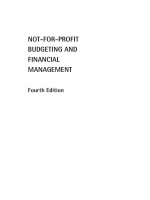Material and financial management by c m sadiwala
Bạn đang xem bản rút gọn của tài liệu. Xem và tải ngay bản đầy đủ của tài liệu tại đây (1.17 MB, 267 trang )
THIS PAGE IS
BLANK
NEW AGE INTERNATIONAL (P) LIMITED, PUBLISHERS
PUBLISHING FOR ONE WORLD
New Delhi · Bangalore · Chennai · Cochin · Guwahati · Hyderabad
Jalandhar · Kolkata · Lucknow · Mumbai · Ranchi
Visit us at www.newagepublishers.com
Copyright © 2007, New Age International (P) Ltd., Publishers
Published by New Age International (P) Ltd., Publishers
All rights reserved.
No part of this ebook may be reproduced in any form, by photostat, microfilm,
xerography, or any other means, or incorporated into any information retrieval
system, electronic or mechanical, without the written permission of the publisher.
All inquiries should be emailed to
ISBN (10) : 81-224-2346-9
ISBN (13) : 978-81-224-2346-4
PUBLISHING FOR ONE WORLD
NEW AGE INTERNATIONAL (P) LIMITED, PUBLISHERS
4835/24, Ansari Road, Daryaganj, New Delhi - 110002
Visit us at www.newagepublishers.com
Contents / v
Preface
The developing countries like India are facing the various types of problems about materials
and other resources, which are scarce or imported from other countries. The various Industries,
which will have to compete with Internationally, established manufacturing organizations to
manage their production and materials they are marketing and procuring after liberalization
to sell their products at the competitive rates have to purchase, store and produce their
products very economically. After liberalization Industries in our country have realized the
importance of materials and financial management to manage and utilize all their resources
in the best possible way. The revolutionary changes have been taking place in Industries for
various activities to optimize the cost of materials and production operation. The Industries
in our country and globally are managing their resources and all types of materials by the
new techniques, methods and use of computers to utilize them most economically considering
various costs involved in purchasing, procuring, storing and utilizing various types of materials
and products. The materials and financial management is the subject which deals with the
study of techniques of appropriate materials supply and materials flow procedures to control
the production system. It helps in materials management and control of inventories. The
financial management shows how to economize the cost of purchase of materials and inventory
control. It is therefore necessary to introduce and teach our students studying for graduation
and post graduation in engineering, management, finance, economics and science the subject
of ‘Materials and Financial Management’. This subject is the part of syllabus of B.E., B.Tech.,
AMIE, M.B.A. M.Tech., M.E., M.C.A., and other management and engineering courses,
practitioner engineers working in various organizations and competitive examinations. The
various Universities in India and other countries have prescribed this subject in various
Engineering and Management Institutions in their course of study.
I have attempted to introduce and cover the various topics of materials and financial
management in this book. I have also emphasized the need for materials management in
every Industry and other organizations to manage and economize their costs. The stores
planning and control is very essential in every organization to manage and control the
various types of materials, items and parts required to manufacture and market their outputs
to develop and meet the demands of their customers and market. The materials management,
inventory control, materials purchasing and supply chain management, stores control,
standardization, simplification, classification, coding of materials and forecasting are the part
of materials management department. Break even analysis, inventory planning and materials
requirements planning, manufacturing resources planning, cost control, value engineering
help in financial management of the organization. M.R.P.- I and M.R.P.- II, Just in time,
materials handling, automatic storage and retrieval system, CAD/CAM, Flexible manufacturing
system, computer integrated manufacturing and value engineering are the recent fields in
vi / Materials and Financial Management
industrial engineering which have practical applications in all the manufacturing and other
types of organizations. The use of computers has become essential in materials management.
MRP is the computerized system to control manufacturing activities using database management
system. Vast amount of clerical work, employees activities and other work involved in the
organization in continuously changing conditions to receive customers orders, delays in
receiving materials supplies, machines breakdowns and timely delivery of production for sales
are the information the management must receive for appropriate decisions in time. MRP,
ERP and MIS have made it possible.
This book of ‘Materials and Financial Management’ is useful to all engineering,
finance, management students and practicing engineers in organizations for their study and
practice. The topics included in this book are given below:
Chapter – I
Materials Management
Chapter - II
Purchasing and Supply Chain Management
Chapter - III
Stores Management and Control
Chapter – IV
Standardization, Simplification, Classification and Coding of materials
Chapter – V
Forecasting
Chapter – VI
Inventory Planning
Chapter – VII
Materials Requirements Planning
Chapter – VIII
Break Even Analysis
Chapter – IX
Inventory Control
Chapter – X
Value Engineering
Chapter – XI
Materials Handling
Chapter – XII
Just in Time
All these topics and their contents mentioned above in various chapters from I to XII are
essential to study and implement the techniques of Materials and Financial Management in
any organization to work efficiently and productively. They are therefore introduced in various
Universities and Institutions in India and all over the World as part of the curriculum in
Engineering, Technology and Management studies for B.E., B.Tech., AMIE, M.E., M.Tech.,
M.C.A. and M.B.A. examinations. It will also be useful for general study by any one.
The suggestions are welcomed from the readers of this book for any mistakes, omissions,
additions and improvement in the book.
Chandra Mohan Sadiwala
Ritesh Sadiwala
Contents / vii
Acknowledgement
This Project of writing the book on Materials and Financial Management and its Publication
is completed because of encouragement from my wife, my children and students. I am very
much thankful to them.
The patience and timely encouragement to me and helping me to write the book, the
author’s wife Srimati Uma Sadiwala, daughters Srimati Minal Wani and Srimati Manisha
Kanugo and son Shri Ritesh Sadiwala who had also written some chapters and helped me in
typing the book and editing supported me in spite of all inconvenience and problems arising
time to time to complete the work. They deserve all praise and thanks from me for their help
and endurance.
The suggestions for further improvements in the book and inclusions of new topics for
further editions will be invited from the students and readers. I am grateful to the publisher
M/s New Age International (P) Limited Publishers and thank them for initiating this project
on ‘Materials and Financial Management’ and its timely completion.
Chandra Mohan Sadiwala
THIS PAGE IS
BLANK
Contents / ix
CONTENTS
Preface
(v)
Acknowledgement
(vii)
CHAPTER I
MATERIALS MANAGEMENT
1
Introduction
Definition
Historical Background
Objectives and Functions of Materials Management
Scope of Materials Management
Integrated Materials Management Concept
Average Expenditure on the Materials by Various Industries
Types of Materials
Materials Management Organization
Questions
CHAPTER II
PURCHASING AND SUPPLY CHAIN MANAGEMENT
Introduction
Definition
Supply Chains
Objectives of Purchasing
Functions of Purchasing
Types of Purchases
Raw Materials
Semi-finished Products, Parts of Componets
Finished Producing
Maintenance, Repair at Operating Items (MRO)
Services Ca[ota; Equipment
15
x / Materials and Financial Management
Production Support Items
Purchase and Supply Chain Organization
Qualification, Duties and Responsibilities of Purchasing Officer
Purchasing Policy and Procedure
Process of Purchasing
Purchase of Machines or Equipments
Purchase Decisions
Supplier Selection
Delivers Terms
Cancellation of Breach of Contract
Supplier Evaluation and the Performance Measurements
Supplier Evaluation Criteria
Rating the Vendors
Purchase Systems
Questions
CHAPTER III
STORES MANAGEMENT AND CONTROL
Stores or Warehouses
Classification of Stores
Centralized and Decentralized Stores
Stores Management and Store Keeping
Objectives of Store Keeping
Functions of Stores
Organization of stores
Duties and Responsibilities of Chief Storekeeper
Qualifications of Storekeeper
Types of Warehouses and Stores
Organizing Stores
Receipt Procedure
Methods of Storing the Materials
Issue of Materials
Material Return
Records of Store
Valuation of Stock and Materials
Layout of Stores
39
Contents / xi
Preservation of Materials and Protection of Stores
Auditing the Stores Materials
Verification of Materials
Security of Stores
Materials Accounting
Questions
CHAPTER IV
STANDARDIZATION, SIMPLIFICATION, CLASSIFICATION
AND CODING OF MATERIALS
72
Standardization and Simplification of Materials
Aims of Standardization
Advantages and disadvantages of Standardization
Scope and area of Standardization
Standardization of Materials and Items
Benefits of Standardization to the organization
Classification of Standardization
Levels of Standards
Simplification
Advantages of Simplification
Difference Between Simplification and Standardization
Rationalization
Classification and Codification
Classification of materials
Codification
Stores Vocabulary
Systems of Codification Used
Cataloguing
Questions
CHAPTER V
FORECASTING
Introduction
Sales Forecasting and Estimating
Types of Forecasting
Methods of Forecasting
89
xii / Materials and Financial Management
Time Series Analysis
Regression and Correlation Analysis
Logarithmic, Straight Line or Exponential Method of Sales Trend Measurements
Selection and Procedure for Forecasting
Questions
CHAPTER VI
INVENTORY PLANNING
118
Introduction
Definition
Necessity and Reasons for Inventories
Functions of Inventories
Types of Inventories
Advantages and Disadvantages of Storing Inventory of Materials
Inventory Planning
Objectives of Inventory Planning and Management
Storage and Movement of Materials
Requirements of sales forecast for operations
Inventory Planning and Control Systems
Questions.
133
CHAPTER VII
MATERIALS REQUIRMENTS PLANNING
135
Introduction
135
MRP System
135
Uses of MRP by a Manufacturing Concern
136
1. Bill of Materials File
2. Item Inventory File
Development of MRP
137
Computer Program
138
Flow chart
138
Toy Car Manufacturing
140
Application of MRP system and its Computer Model
140
Manufacturing Resources Planning
148
Contents / xiii
CHAPTER VIII
BREAK-EVEN ANALYSIS
152
Introduction
152
Break Even Chart and Break Even Point
152
Finding Break Even Point and Margin of Safety
153
Margin of Safety
153
Angle of Incidence
153
Graphical Presentation of BEP
154
Cost, Volume and Profit Analysis
160
Make or Buy Decisions of Products
161
Music-3D
162
Question
164
CHAPTER IX
INVENTORY CONTROL
163–189
Introduction
165
Types of Inventory Control Systems
165
Safety Stock
167
Influence of Uncertainty on Inventory Control
167
Determination of Safety, Buffer or Reserve Stock
168
Variables in Inventory Problems
169
Demand Pattern of Items Required
169
Essentials of Inventory Control
170
Elementary Inventory Control Models
170
Costs Involved in Inventory Control Problems
170
Classification and characteristic of Inventory problems
171
Deterministic Models of Inventory control
173
Inventory Control Model-I
174
Inventory Control Model-II
176
Inventory Control Model-III
178
Price discount in Inventory control
Economic Order ------------ with Price discounts
179
Verification of Stock
185
Methods of Physical Verfication of Stock Taking
186
Questions
188
xiv / Materials and Financial Management
CHAPTER X
VALUE ENGINEERING
189
Value Engineering or Value Analysis
190
Objective and Purpose of Value Engineering
191
Aims and Philosophy of Value Analysis
192
Value Engineering Job Plan
193
Determination of Cost
195
Questions
205
CHAPTER XI
MATERIALS HANDLING
206
Minimizing Materials Handling
206
Relationship of Materials Handling and Facility Planning
206
Desiying a Material Flow
207
Objectives of Materials Handling
207
Functions of Materials Handling
207
Desying the Materials Flow Patterns
208
Developing the Material Flow Pattern
209
Convey or analysis
209
Material Handling at the Work Place
211
Introduction to Material Handling Activities
211
Principles of Material Handling
211
Material Handling Methodlogy
213
Material Handling Safety
214
Materials Handling Equipments
214
Selection of Material Handling Equipments
215
Basic Material Handling systems
223
Automatic Storage of Retrieval systems (AS/Rs)
228
Questions
230
CHAPTER XII
JUST IN TIME
231
Introduction
231
The Principles of TIT
232
Objectives of JIT
232
Requirements of JIT
233
Contents / xv
Just in Time Methodlogs
233
Zero Inventors (ZIN) system
234
KANBAN
234
Drawlacks of JIT
234
Case Studies
235
Questions
237
Appendix I – V
238
References
249
Index
251
THIS PAGE IS
BLANK
Materials Management / 1
CHAPTER I
Materials Management
Introduction
Materials Management is simply the process by which an organization is supplied with the
goods and services that it needs to achieve its objectives of buying, storage and movement
of materials. Materials Management is related to planning, procuring, storing and providing
the appropriate material of right quality, right quantity at right place in right time so as to
co-ordinate and schedule the production activity in an integrative way for an industrial
undertaking. Most industries buy materials, transport them in to the plant, change the
materials in to parts, assemble parts in to finished products, sell and transport the product
to the customer. All these activities of purchase of materials, flow of materials, manufacture
them in to the product, supply and sell the product at the market requires various types of
materials to manage and control their storage, flow and supply at various places. It is only
possible by efficient materials management.
The materials requirements planning, purchasing, inventory planning, storage, inventory
control, materials supply, transportation and materials handling are the activities of materials
management. They will be discussed in details in various chapters to follow.
About 20-25 years ago, there was no cut-throat competition in the market to sell the
various consumer items manufactured by different industrial undertakings and the availability
of materials to manufacture these items was not scarce. Therefore, materials management
was not thought to be so important and its separate identity in the organization was not felt.
But today it has become an important management activity to streamline production.
Actually before the production begins it is necessary to ensure availability of all the types
of materials needed for production and its supply at the various production centers. Planning,
purchasing and scheduling are the main functions of materials management. It aims at
improved productivity. It is used to reduce the cost, which increases profitability and streamlines
the production. Apart from management of material cost and its supply it helps in its proper
utilization, transportation, storage, handling and distribution.
The market research and forecasting both for sales of company’s product and purchasing
of various materials required for producing the product are needed at the planning stage.
Purchasing, procurement of materials, transportation, storage, inventory control, quality
control and inspection of materials and goods supplied at various production centers before
production are also managed as routine work. Materials handling, packaging, warehouse
2 / Materials and Financial Management
planning, accounting, scrap, surplus and obsolete materials disposal, finished goods safety and
care are the activities managed by the materials management department.
Selection of personnel for marketing, purchasing, inventory control, stores management
and materials handling and their training and placement is also to be seen by the materials
management department
This indicates that it is very essential to have a materials management department in
any organization to support the management in the production activities. It also helps in the
marketing, sales promotion and control of all the types of materials for its quantity, quality
and cost.
Definition
The International Federation of Purchasing and Materials Management accept the
definition of materials management given below. According to it, materials management is
a total concept having its definite organization to plan and control all types of materials, its
supply, and its flow from raw stage to finished stage so as to deliver the product to customer
as per his requirements in time. This involves materials planning, purchasing, receiving,
storing, inventory control, scheduling, production, physical distribution and marketing. It also
controls the materials handling and its traffic. The materials manager has to manage all
these functions with proper authority and responsibility in the material management
department. The historical background about the materials management is as follows.
Historical Background
The scarcity of materials, which was felt during World War I in USA to a very large
extent and it, has become difficult for production managers to supply the War goods. This has
created it necessary to organize the Materials Management department for managing large
inventories in stores and to analyze the problems arising to control and economize inventory
cost problems and shortage elimination. The materials management was included as an
important function of the management.
With the development of principles of scientific management by F.W. Taylor in 20th
century, the economic use of materials in all the organizations was critically felt to reduce
the cost of production.
The early years of developments in the field of materials purchase and supply systematically
begins from 1850. Charles Baggage’s book on the economy of machinery and manufacturing
published in 1832 refers to the importance of purchasing function. Baggage is also known as
“Materials Man”.
The growth of Rail Road industries by 1866 started in America. The Book on ‘The
Handling of Railway Supplies and their Purchase and Disposition’ in 1887 discussed the
purchasing issues. Purchasing gained importance during World War I. Howard T. Lewis was
a purchasing professional from 1905 to 1945. He developed importance of sound procurement
to company operation.
The concept of materials management was widely spread during World War II. Professor
Howard T. Lewis of the Harvard Business School made the extensive studies in Industrial
Purchasing Practice. W.N. Michelle, N.F. Harriman, L.F. Buffy, Donald G. Clark, Edward T.
Gushee, Russell Forbes, Stuart F. Hewritz and George A. Reward had contributed largely to
Materials Management / 3
purchasing and materials management in procuring, receiving, inventory control and supply.
World War II introduced a new period in purchasing history. The emphasis on obtaining
required and scarce materials influenced a growth in purchasing interest. In 1933, nine
colleges offered courses related to purchasing which was increased to forty-nine colleges in
1945 in America. The membership of the National Association of Purchasing Agents increased
from 3400 in 1934 to 5500 in 1940.
The post-war period saw the development of the value analysis technique, pioneered by
General Electric Company in 1947 on the evaluation of which materials or changes in the
specification and design would reduce over all product cost. From 1947 to 1960 were 13 years
on further developments in materials management. Firms initiated dramatic growth of the
materials management during 1960-1970. The Vietnam War resulted in upward price and
materials availability pressure. During 1970 Firms experienced widespread materials problems
related to ‘oil shortages and embargoes’.
Widespread agreement between countries taken place with the overall objective to solve
materials problems including materials planning, inventory control, purchasing, quality control,
stores control, materials movement and surplus disposal. The purchasing strategies and
behaviors that evolved over in 1980 gave rise to foreign global competition .
The global era of trading in between 1970 and 1999 for materials management increased.
Purchasing approaches beyond 2000 reflects a changing emphasis towards the improvement
of quality of materials, supplier relationship, more co-operative approach, long-term strategies
of cost management and database materials management systems for materials planning and
utilization in industries to bring about overall improvement in production systems, in-cost
reduction through economy and increased sales. In order to serve the corporate goals and
perform materials activities efficiently, a functional organization of the materials management
must be established to fulfill the objectives of materials program, elimination of materials
wastages and duplication of efforts to do so in every organization. Then only the abovementioned goals of materials management can be achieved.
Objectives and Functions of Materials Management
The objectives and functions of materials management can be categorized in two ways
as follows:
(I) Primary objectives
(II) Secondary objectives
They are discussed below:
(I) Primary objectives
Which can be classified as:
(i) Efficient materials planning
(ii) Buying or Purchasing
(iii) Procuring and receiving
(iv) Storing and inventory control
(v) Supply and distribution of materials
(vi) Quality assurance
4 / Materials and Financial Management
(vii) Good supplier and customer relationship
(viii) Improved departmental efficiency
(II) Secondary objectives
There can be several secondary objectives of materials management. Some of them are
given below:
(i) Efficient production scheduling
(ii) To take make or buy decisions
(iii) Prepare specifications and standization of materials
(iv) To assist in product design and development
(v) Forecasting demand and quantity of materials requirements
(vi) Quality control of materials purchased
(vii) Material handling
(viii) Use of value analysis and value engineering
(ix) Developing skills of workers in materials management
(x) Smooth flow of materials in and out of the organization
To fulfill all these objectives, it is necessary to establish harmony and good co-ordination
between all the employees of material management department and this department should
have good co-ordination with the other departments of the organization to serve all production
centers.
The basic objectives of management in an organization are:
(1) Sales increase through sales promotion
(2) Profit maximization
(3) Improvement in customer services
(4) Globalization of its product sales
(5) Meet the technological changes
(6) Good employer - employee relationship
(7) Selection of alternative materials
(8) Reduction in manufacturing and other cost.
(9) Social objectives
In order to fulfill these basic objectives of management the objectives of materials
management should be set in such a way that they should totally help to meet ultimate goals.
The functions of materials management are discussed below:
In order to fulfill the objectives of materials management as stated above to meet the
basic objectives and goals, the functions of the materials management are also categorized
as primary and secondary functions.
(I) Primary Functions
To meet the primary objectives, the primary functions of the materials management are
given as follows:
Materials Management / 5
(i) Materials Requirements Planning (MRP)
Planning of materials requirements in manufacturing is a necessary function in any
organization, as inventory of materials involve about 60% of the total investment of the
organization. The profit earned depends on the utilization of these materials and reducing the
inventory of the materials.
The latest technique used is called Just in Time (JIT) is referred practically to no inventory.
However, in the present situations in any of the organization particularly manufacturing
organization, it is not absolutely possible to keep no inventory of materials required for production.
The MRP is a technique used to plan the materials starting from the raw materials, finished
parts, components, sub-assemblies and assemblies as per Bill of Materials (BOM) to procure or
produce them to support a Master Production Schedule (MPS). It is used on computers
productively by any company that uses a MPS to manufacture products that require assemblies,
components and materials to produce the final products. The MPS is exploded using the bills
of materials to determine requirements of lower-level assemblies, components, finished parts
and raw materials. It plans orders to meet these needs.
(ii) Purchasing
All the organizations needs an efficient and economic purchasing and procurement of its
various supplies of materials from the suppliers. The materials management department has
to perform this function of purchasing and procurement of materials very efficiently. Since
50% to 60% of sales turnover is spent on the purchase of various materials, the amount of
profit earned on this sales very much depends how economically the materials are purchased
and utilized in the organization. The profitability depends on the efficiency by which this
particular function of purchasing and procuring the requisite materials at appropriate time
will be done and its availability is assured.
The function of purchasing can be stated as follows:
(1) The requisition of material is necessary by proper authority to initiate its purchase.
(2) To select proper supplier for the materials requisitioned, before placing an order.
(3) To negotiate about the price of the material from the supplier and it will be
purchased at the cheapest price.
(4) The quality of material must be assured and should not be compromised with the
cost of the material.
(5) The material should be purchased of right quantity and right quality at proper time
at the cheapest cost.
(6) To set the proper purchase policy and procedure.
(iii) Inventory Planning and Control
The modern concept of inventory planning is that the materials should be purchased and
brought in the stores just before it enters the production or sold out so that inventory cost
is negligible. The zero inventories are the ideal planning. There are three types of inventories.
(i) Raw materials
(ii) Purchased goods
(iii) Finished parts and components
6 / Materials and Financial Management
The inventory control of these various materials lies with the materials management
department, production department and sales department. Inventory at different levels is
necessary to make sure about the availability of all these types of materials and goods and
their proper flow from one facility to another at different levels of production centers in a
manufacturing concern.
The storing of various types of materials and parts as inventory is therefore very
essential before its delivery and use at different production centers. This involves inventory
planning and control of materials in the stores department. Many a time, the supplier may
not be in a position to supply the materials of the ordered quantity at the proper time. To
maintain the continuity in production and line balance in assembly work, the various types
of inventories are necessary to be maintained and kept in the stores. as shown in Figure
1 given below.
Inventory
Raw Materials
Process
Inventory
Parts
Process
Components
Fig. 1. Inventory of materials
The raw materials before being supplied to a production process, some of it is sent to
store as inventory and rest is sent to production facility as per its requirements and in the
same way, various parts manufactured and assembled as components and assemblies are also
stored as finished parts inventories at the different places in the stores. The final products
before being supplied to the customers are also stocked as inventory of the final products of
the organization to meet the fluctuating demand and to regularize the supplies in the market.
Thus, the inventory control is a very important function of the materials management
department. The various types of inventory models are developed for the different materials
to economise the purchase, supply, inventory control and production control to analyze and
optimize the costs involved in ordering, set-up and inventory carrying of materials required
in the production.
(iv) Ascertaining and Maintaining the Flow and Supply of Materials
Distribution of materials requisitioned by the various production centers and other
departments must be ascertained and its flow and continuity of supply must be maintained
by the materials management department. Insufficient or zero inventories many times create
the situations of stock-outs and leads to stoppage of production. Failure of materials handling
devices is also responsible for disruption of material supplies. Alternatives or emergency
supply systems can be used for assuring production lines to continue.
Uncertainty in demand and production quantity is the main factor. As the customer
requirements as per his needs and liking, are changing very fast. The management has to
maintain continuity in production to meet this uncertainty in demand and control the situation
by proper flow of materials supply and distribution at various production facilities and other
departments as per changes in production quantity.
(v) Quality Control of Materials
The quality of the product manufactured by the organization depends upon the quality
of the materials used to manufacture that product. It is a very important and necessary
Materials Management / 7
function of materials management to purchase the right quality of materials. The inspection,
quality control, simplification, specification, and standardization are the activities which are
to be followed for the measurement of quality of the materials. The quality assurance is
decided by inspection and checking. The various properties of materials as per their
specifications and standard. The size and dimensional measurements within tolerance limits
assures the interchangeability and reliability of components and parts.
Quality is largely determined by consumer taste and liking. The market is under buyer’s
control. Customer decides the quality of the product. Material quality control aims at delivering
product at higher and higher quality at lower cost. The product will be specified not only by
its dimensional accuracy but its quality standards, durability and dependability, high
performance, reliability and aesthetic value. Each of this factor aids cost to the product. In
order to achieve high quality, the materials input to the product should be of high quality,
which will have higher cost. The performance decides the reliability, which is obtained
through high quality production. The performance is checked by quality inspection and accuracy.
This also aids cost to the product. The quality of the materials also decides the selection of
vendors and the relationship between buyers and suppliers. The specifications, size and
quality of materials must be referred and if possible the standard should be followed for
specifications and sizes. The types of tests required for assuring the quality should be specified
and conducted to establish the standards.
(vi) Departmental Efficiency
The objective of this function is to ensure the efficiency of the system adopted. If the
system and procedure adopted for materials management are inefficient or faulty, none of the
objectives mentioned above can be fulfilled, howsoever the procedure may be good. In order
to maintain the things in proper way as per planning an efficient control is necessary in the
department over each and every process. Management Information System (MIS) and feed
back control at every stage of working must be adopted to control and make the management
and employee work as efficiently as possible to achieve the best results.
(II) Secondary Functions
There can be number of secondary functions. Some of them are discussed below:
(i) Standardization and Simplification
The standards and specifications of various types of materials are fixed by design and
technical department of the organization and they are followed by production department.
Standards define the quality, reduction in sizes and variety, interchangeability of parts and
products. It ensures efficient utilization of materials and reduces wastages. Standard materials
are always available at reasonable cost. It also helps purchasing department in selection of
materials and vendors. If less variety of items purchased and put in the stores the types of
inventories will be reduced and in this way the cost of carrying the inventories in the stores
will be reduced. The objective of this function will be to produce standard product reducing
the overall cost of the product.
(ii) Design and Development of the Product
The variety in product and functionality are the important factors to promote the sales
of a product. The new techniques of designing a product using Computer Aided Design (CAD)
8 / Materials and Financial Management
has made possible to develop variety of products at faster rate. The new technological
development in manufacturing using Computer Aided Manufacturing (CAM) can produce
variety of products at much faster rate with all types of flexibility in the manufacturing as
compared to conventional methods.
Materials management department has to act according to use of such variety of materials
to produce variety of parts and ensure the supply of such materials. It should also be decided
how to purchase and produce such variety of products with flexibility and economic cost.
(iii) Make and Buy Decisions
These types of decisions are the policy decisions of the management. The capacity of the
organization and the various facility developed by the organization to manufacture various
items is the main objective of every organization. This is the important planning activity of
every undertaking. But when a company grows fast, its sales increases at rapid rate then it
becomes an important matter to decide whether the company should buy the parts and
components or increase and establish its facilities to cope up with the increased demand and
sales. This will be greatly concern to materials management department. It will help in
selecting the suppliers to buy the items at reduced cost. The material evaluation, its availability,
alternative materials selection, procurement and inventory control are the functions influence
the make and buy decisions.
The make and buy decisions are largely based on cost economics and cost benefit analysis
made by the organization using the existing production capacity of labor, skill and machines
available with the factory and how best they can be utilized.
(iv) Coding and Classification of Materials
This is an important function of the materials management to help the production and
purchasing department of every organization. It uses its own methods of classification of
materials used to manufacture the product or a company selling various goods. ABC analysis
is one of the simple and standard method used by most of the firms for classification and
storing their variety of materials.
The materials are recognized to purchase and store as an inventory by its codes and
nomenclatures. The various methods of coding are used by every organization to control the
variety of materials and its quantity and price rates.
(v) Forecasting and Planning
Materials requirements planning is based on correct forecasting of sales and demand of
the products in the market. The market fluctuations are to be observed to control production
of the organization. The various methods of forecasting are available and the materials
management department can choose the one which gives the best results to the company.
Forecast of future demand of sales sets the planning of materials supply. Analytical
methods are adopted for systematic forecasting and planning to procure the various materials
required for production.
In case of fluctuating demands, there can be uncertainties in supply as well. This can
be overcome by maintaining the proper quantity in inventory of short supply materials at
proper time. The different techniques available to use correct forecasting have to be utilized
by materials manager to plan the procurement, purchase, supply, managing the outside









